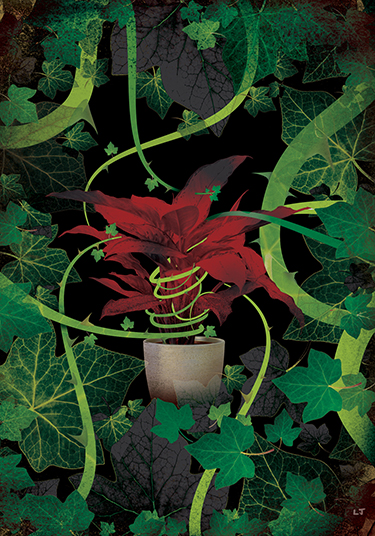Discoveries
Tumors & Plants: What They Have in Common
Jan 16, 2020 Cedars-Sinai Staff
Cancer cells can reshape their surrounding environments—just like invasive plants.

Illustration: LJ Davids
The tactics of cancer cells extend beyond rampant tumor growth. They also remodel their surroundings into a cancer-friendly neighborhood called the tumor microenvironment. This process is complicated, and scientists are striving to elucidate it. For noncancer biologists, a metaphor can help explain the phenomenon: Cancer’s microenvironment landscaping is reminiscent of the way invasive species of plants like English ivy and kudzu crowd out native flora.
At Cedars-Sinai, CS Cancer investigators are looking for ways to reclaim the tumor microenvironment, transforming it into fertile ground for immunotherapy and targeted therapies, says Robert Figlin, MD, director of the Division of Hematology/Oncology and the Steven Spielberg Family Chair in Hematology-Oncology.
“Cancer cells only have one mission: live, grow, proliferate,” Figlin says. “If the environment they create can be readjusted in favor of destruction of the cancer cells, that gives us an advantage in helping patients.”
This strategy doesn’t directly attack the cancer cells, but it weakens their defenses and makes them more susceptible to treatments—a bit like changing growing conditions to discourage an invasive weed from further choking other plants.
Discoveries asked a handful of cancer and plant experts to extend the metaphor.
|
|
Tumor Microenvironment |
Invasive Plant Environment |
|---|---|---|
|
The basics |
A tumor microenvironment includes cancer cells that surround healthy cells and “rogue” cells that have been recruited by cancer cells. Interactions among these cells create the microenvironment. |
A species is defined as invasive when it outcompetes native plants for resources. This can change how local birds and animals eat, nest and interact with their environment. |
|
Grabbing liquid resources |
Tumor cells in the microenvironment send out signals to recruit blood vessels to grow into the area to feed the tumor. |
Saltcedar, an invasive shrub, grows a long taproot deep into the soil, starving surrounding plants of adequate water. It can soak up more than 30 gallons of water daily. |
|
Poisoning the competition |
Healthy cells produce collagens the body needs to function normally. Cancer changes the types of collagens that healthy cells produce to help the cancer cells grow and spread. |
Saltcedar exudes a toxin that prevents other plants from growing. |
|
Hiding out |
Fibroblasts, cells usually found in connective tissue, seem to play a role in hiding cancer cells from the immune system. |
English ivy, originally planted as a ground cover, climbs up trees and hides plants below from the sun. |
|
Hot spots |
Larger tumors increase glucose metabolism, creating a kind of “hot spot” in the body. |
Some invasive plants—like red river gum, a kind of eucalyptus—burn hotter even than California’s native chaparral, increasing the risk of wildfires. |


